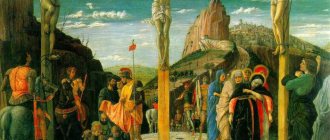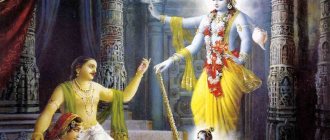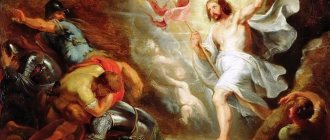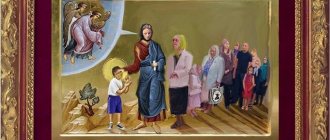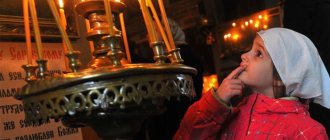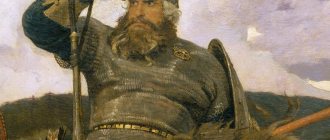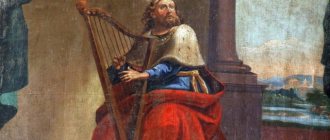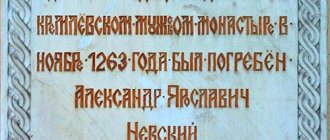There were times in the history of the Russian church when the faith was kept by “white handkerchiefs” - grandmothers, albeit poorly educated, but raised in Orthodoxy and who could not imagine their life without the church. They were the ones who went to temples without fear of persecution by the authorities. They secretly baptized their children and grandchildren - and those, already adults, looking back at their lives, understood what kind of power protected them, whose prayers protected them from troubles and evil.
These were times when prayers were copied by hand in notebooks, it was impossible to buy the New Testament in a bookstore, and you could be expelled from the Komsomol for having a cross on your neck.
Today people are not persecuted for their faith, new churches are being built, and in each of them there are books and magazines. There are Sunday schools for children and adults. There are many Orthodox websites and Internet channels. Priests hold conversations and deliver sermons. It is all the more surprising that, along with the veneration of the saints, our fellow citizens succumb to the tricks of false elders and false prophets.
One of them is the “elder” Alexy, called Penza.
Alexey Penzensky (Mikhail Shumilin)
Biography
Usually saints are named after the place where they came from, where they labored, or where they suffered. The “elder” was born on November 10, 1930 in the village of Lomovka, Penza region. His real name was Mikhail Shumilin. In the books they talk about him “in the world,” but in fact he remained in the world.
According to the canonical rules for ordination to the priesthood, physical illnesses and disabilities that prevent the performance of divine services serve as an obstacle to this (Apostolic canons 76 and 77). And Mikhail Shumilin was born with a serious illness: he could not walk (he moved in a wheelchair, and then with the help of other people). He had poor use of his hands and could not speak - his speech was slurred.
It is unlikely that such a seriously ill person was capable of creating his own cult, much less a sectarian “church.” This is the “merit” of the people around him.
We know how much a mother means in a person’s life and especially in the life of a saint: the lives of saints are filled with examples of the selflessness of the mothers of saints, martyrs and martyrs. Mothers raised their children in the faith - there are even entire families known that gave the church not one, but many saints (like the families of Basil the Great and Gregory the Theologian). Mothers strengthened their children during martyrdom (like Saint Sophia, the mother of Faith, Hope and Love).
It is even more strange when mothers push their children - especially the sick and helpless - onto the wrong path. A striking example of this is the mother of the “youth Slavik of Chebarkul”, from a child who died at the age of eleven from leukemia, she made a pseudo-saint, and from his memory - a cult.
So with the Penza “elder” his mother, Anna Shumilina, was there. She served as a “translator” because the “saint’s” speech was slurred.
The young disabled man was transported to Penza in 1952, where he lived in the apartments of “admirers.” Even then, people appeared who called Mikhail a “seer.” A community of people who had departed from Orthodoxy formed around him. They created a pseudo-elder cult following “prophecies” that are superstitions.
At the same time, the sectarians used the helpless disabled person for their own purposes. The photographs show that the “old man” can hardly hold his head up, and during trips he was tied with belts so that he could sit. His “prophecies” were unclear, and they were interpreted by the women who were under Shumilin (first his mother, then a nun).
8
January
2005
“Elder Alexei of Penza” died, but the community of his admirers still exists today.
Architectural ensemble
The buildings on the territory of the monastery vary in style, some are decorated in traditional minimalist Russian lines, others are striking in bright colors and patterns. In total, there are 8 churches in the parish, the most important is the Cathedral of the Resurrection of Christ, which was built in 2002 and received the nickname “Snow-White Pearl”.
Cathedral of the Resurrection of Christ Barsanuphievsky Monastery
The cathedral was designed by the architect Kurbatov, who decided to erect a large 10-domed temple with a bell tower. The cathedral was founded in 2002, and it was finally consecrated and put into operation in 2004. The height of its bell tower reaches 39 meters, and the total weight of 8 bells is 200 pounds. The cathedral is only 35 meters long and 20 meters wide, its total area is about 680 square meters. m, and in its shape the cathedral resembles a cross.
Barsanuphievskaya Church, which was the very first one built in the parish in 1756 and was previously called St. Nicholas Church, has almost completely collapsed during its entire existence. But after the departure of Soviet power, the nuns began to restore it.
Interesting! After a long restoration, the temple was consecrated again in 1992 (at the same time it became Varsonofievskaya) and services immediately began to be held in it. It is built like a basilica and has only one dome.
The house church, which was built in 2010 and consecrated in honor of the healer Panteleimon. It is located in the same building where the almshouse was located, only on its first floor.
The house church, which was consecrated in 2000 in honor of the Intercession of the Most Holy Theotokos, is located in the cell building on the lower floors. And in the attic they located the Church of St. Nicholas, which was consecrated in 1999. The building with these temples was rebuilt from a village school; it underwent numerous changes and was restored almost from ruins.
On the territory of the holy spring, the Church of the Icon of the Mother of God “Life-Giving Spring” was erected instead of the old wooden chapel. The church, which also houses a closed chapel, was consecrated in 2012 by Bishop Clement.
The Gate Church of the Archangel Michael is one of the youngest in the courtyard, it was built in 2005 and consecrated in 2012. Like the Barsanuphievsky Church, it has only one dome, but its construction and decoration are still ongoing.
Church of the Archangel Michael in the Barsanuphievsky Monastery
The parish also includes a wooden church in honor of the holy martyr Vladimir in the village of Novye Vyselki (1.5 km from the monastery courtyard) and the old wooden Church of the Nativity in Pokassy - it is an architectural monument of the 19th century.
When and how did the community of worshipers arise?
In Soviet times, the “Mikhailovtsy” were an underground community, but in the 1990s, when all the bans were lifted, they came out into the world, began traveling to holy places, and at the same time they were working to create their own “church”, which in the late 90s -x ends with the construction of a temple in the village of Pobeda and the creation of a “monastery”.
Followers of the “elder” claim that he spent his life in constant prayer, is famous for many healings, and also uttered prophecies according to which the members of his community live.
Interesting fact
In 2007, a book entitled “According to your faith be it done to you...” was published. It sets out the “truth” about Alexei Penzasky.
So, the book says that he took monastic vows in the early 1960s, and received a blessing for this from the Monk Amphilochius of Pochaev. It is emphasized that Alexei receives spiritual succession from the Glinsky elders. And he was tonsured into the schema in 1992, allegedly blessed by Archbishop Seraphim of Penza and Kuznetsk. It is known for certain that Seraphim not only did not give such a blessing, but also had a negative attitude towards the “Mikhailovites” and their activities, especially speaking out against their construction of the temple.
It is a deception to mention that the books “The Road to the Elder” and “According to Your Faith May It Be Done for You...” were published with the blessing of the church.
Activities of the parish
The parish has been led by Archimandrite Alexy (Degaev) since February 1992. He went from abbot of the monastery to confessor and abbot. Today he directs all the activities of the parish, conducts services and meetings with pilgrims and parishioners.
The nuns take special care of the younger generation, which is why a shelter is opened here for orphans or those who find themselves in difficult life situations. Today, 5 disabled children live and are raised here permanently, as well as from 3 to 18 girls in need of housing and assistance.
Those living in the shelter often live in cells with nuns, so that they can help them grow as spiritually healthy people by positive example. There is a kindergarten on site for children whose mothers live in the monastery as nuns.
There is also an almshouse at the monastery - about 20 nuns and elderly women who need care and concern live there. All residents regularly attend divine services, and those who are bedridden participate in the Sacrament of the Eucharist with the help of nuns.
Divine services in the monastery are conducted by Abbot Alexy
Sisters with medical training at the almshouse have opened an outpatient reception center and receive pilgrims, local residents and nuns, trying to alleviate illnesses and provide first aid. The monastery is entirely self-sufficient through agriculture. Here the nuns do:
- growing vegetables and fruits, as well as wheat crops and feed;
- livestock breeding (production of dairy products);
- maintaining a poultry house (chickens, ducks, turkeys);
- beekeeping;
- herbalism (pharmaceutical herbs are grown in the local garden, ointments and balms are made, and medicinal mixtures are prepared);
- fishing (carp are grown in a local pond).
On the farmstead there is a printing, bookbinding and sewing workshop, a bakery (bread and prosphora are baked), a smokehouse and a curing room (fish, vegetables and fruits are stored for the winter). In 2016, a church history museum was opened at the parish, dedicated to the history of the village, the culture of Mordovia and the traditions of the local people. The nuns necessarily participate in the work, taking on responsibilities in one of the areas of the parish’s activities.
Shrines and patronal feasts
In the monastery, the main relic is considered to be the holy spring in honor of the Mother of God “Donskaya”, whose waters are considered miraculous and healing. A small chapel of the same name was built near the source (in 2000) and an indoor bathhouse, which is used to bless the water on Epiphany and other holidays.
Mosaic icon of St. Barsanuphius on the gate church of the monastery
The novices of the monastery especially venerate St. Barsanuphius, Bishop of Tver, whose memorial days are celebrated on April 11 and October 4, as well as Hieromartyr Vladimir, Metropolitan of Galicia and Kyiv, whose memorial days fall on January 25 and June 14. Holidays are also celebrated after which local churches were named:
- St. John the Evangelist (May 21);
- St. John the Baptist (October 6);
- icons of the Mother of God “The Sign” (December 10);
- St. Nicholas (December 19);
- Intercession of the Virgin Mary (October 14);
- vlmchn. Panteleimon (August 9);
- Archangel Michael (November 21);
- Icon of the Mother of God “Life-Giving Spring” (Friday of Bright Week).
In the monastery, the two most revered images are St. Nicholas the Wonderworker and St. Seraphim of Sarov.
Miracles
All the miraculous events that happened here are connected with the holy spring, which is located on the territory of the monastery, but at some distance from the main buildings. It all started long before the founding of the monastery here - when there was only a wooden church here, a local village girl who suffered from blindness prayed and asked the Mother of God to heal her.
Temple in honor of the Icon of the Mother of God “Life-Giving Spring”
The Mother of God heard the pure and sincere prayers of the child and at night appeared to her in a dream, pointing to the source. The child went to the indicated place and washed himself there with clean water. The girl was healed immediately and saw the icon of the Mother of God of the Don that appeared to her.
Interesting! Since then, the spring has been considered miraculous; many people who prayed at it and drank its water received healing from illnesses and were freed from demons and sins.
The second obvious miracle occurred during the construction of the cathedral in the monastery. For a long time the architect could not choose the right and good place for the building. He began to pray and ask God for wisdom; in response to the prayer, a terrible fire occurred on the territory - the building of a local atheist enemy, which he had built from the remains of old church boards, burned down.
Here they decided to build a new cathedral. During construction, in late autumn, a large cross made of frost suddenly appeared on the ceiling of the unfinished building, which remained there until Lent.
How does the Russian Orthodox Church relate to him?
Also called the “St. Michael’s Monastery,” the “community of Elder Alexy” is located in the village of Pobeda. Today the village is part of the city. On the captured site, the community built the Church of the Archangel Michael. There are also buildings on the territory where members of the sect live. They call themselves the “True (or Catacomb) Orthodox Church,” but this has nothing to do with Orthodoxy. Those who “serve” in the temple are not properly ordained, and their canonical affiliation is generally unknown.
And, although pilgrims are assured that this is one of the churches of the Penza diocese, in fact this is not true. For the sake of appearance, at the “services” the names of the Patriarch and the ruling Penza bishop are raised. In fact, the “Mikhailovites” do not have any canonical communication with the Russian Orthodox Church.
Veneration and significance in Orthodoxy
The memory of St. Elder Alexy Zosimovsky is revered on the day of his death, October 2. Father is also venerated on November 18 among the fathers of the Local Church Council.
In conversations with Father Alexy, people found immeasurable love and consolation. Performing prayerful and monastic feats, he possessed the gift of clairvoyance. With his words, Father Alexy healed people's souls, and with his prayer to the Lord God - their bodies. They left confession with a feeling of relief, grace and love. The reverend elder showed his spiritual children the power and wisdom of Divine Providence, and steadily called pilgrims to humility and prayer.
